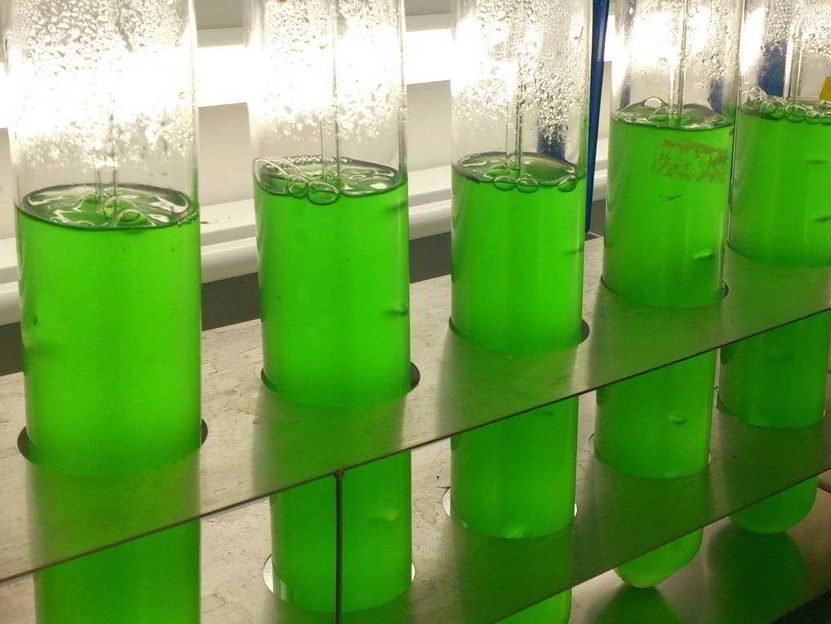Erasing a genetic mutation
Using a new gene-editing system based on bacterial proteins, MIT researchers have cured mice of a rare liver disorder caused by a single genetic mutation.
The findings, described in Nature Biotechnology, offer the first evidence that this gene-editing technique, known as CRISPR, can reverse disease symptoms in living animals. CRISPR, which offers an easy way to snip out mutated DNA and replace it with the correct sequence, holds potential for treating many genetic disorders, according to the research team.
"What's exciting about this approach is that we can actually correct a defective gene in a living adult animal," says Daniel Anderson, the Samuel A. Goldblith Associate Professor of Chemical Engineering at MIT, a member of the Koch Institute for Integrative Cancer Research, and the senior author of the paper.
The recently developed CRISPR system relies on cellular machinery that bacteria use to defend themselves from viral infection. Researchers have copied this cellular system to create gene-editing complexes that include a DNA-cutting enzyme called Cas9 bound to a short RNA guide strand that is programmed to bind to a specific genome sequence, telling Cas9 where to make its cut.
At the same time, the researchers also deliver a DNA template strand. When the cell repairs the damage produced by Cas9, it copies from the template, introducing new genetic material into the genome. Scientists envision that this kind of genome editing could one day help treat diseases such as hemophilia, Huntington's disease, and others that are caused by single mutations.
Scientists have developed other gene-editing systems based on DNA-slicing enzymes, also known as nucleases, but those complexes can be expensive and difficult to assemble.
"The CRISPR system is very easy to configure and customize," says Anderson, who is also a member of MIT's Institute for Medical Engineering and Science. He adds that other systems "can potentially be used in a similar way to the CRISPR system, but with those it is much harder to make a nuclease that's specific to your target of interest."
Disease correction
For this study, the researchers designed three guide RNA strands that target different DNA sequences near the mutation that causes type I tyrosinemia, in a gene that codes for an enzyme called FAH. Patients with this disease, which affects about 1 in 100,000 people, cannot break down the amino acid tyrosine, which accumulates and can lead to liver failure. Current treatments include a low-protein diet and a drug called NTCB, which disrupts tyrosine production.
In experiments with adult mice carrying the mutated form of the FAH enzyme, the researchers delivered RNA guide strands along with the gene for Cas9 and a 199-nucleotide DNA template that includes the correct sequence of the mutated FAH gene.
Using this approach, the correct gene was inserted in about one of every 250 hepatocytes — the cells that make up most of the liver. Over the next 30 days, those healthy cells began to proliferate and replace diseased liver cells, eventually accounting for about one-third of all hepatocytes. This was enough to cure the disease, allowing the mice to survive after being taken off the NCTB drug.
"We can do a one-time treatment and totally reverse the condition," says Hao Yin, a postdoc at the Koch Institute and one of the lead authors of the Nature Biotechnology paper.
To deliver the CRISPR components, the researchers employed a technique known as high-pressure injection, which uses a high-powered syringe to rapidly discharge the material into a vein. This approach delivers material successfully to liver cells, but Anderson envisions that better delivery approaches are possible. His lab is now working on methods that may be safer and more efficient, including targeted nanoparticles.
Most read news
Topics
Organizations
Other news from the department science

Get the life science industry in your inbox
By submitting this form you agree that LUMITOS AG will send you the newsletter(s) selected above by email. Your data will not be passed on to third parties. Your data will be stored and processed in accordance with our data protection regulations. LUMITOS may contact you by email for the purpose of advertising or market and opinion surveys. You can revoke your consent at any time without giving reasons to LUMITOS AG, Ernst-Augustin-Str. 2, 12489 Berlin, Germany or by e-mail at revoke@lumitos.com with effect for the future. In addition, each email contains a link to unsubscribe from the corresponding newsletter.
Most read news
More news from our other portals
Last viewed contents
Yolk_sac

New technology provides insight into the development of immune cells - Barcode system enables researchers to follow which development path the cells take at the same time as identifying which genes are actively transcribed as messenger RNAs

Human neural stem cell grafts used to repair spinal cord injuries in monkeys
Spinifex to be acquired by Novartis - Australian pain drug innovation company sold to Novartis for US$200m plus milestone payments

How the MRSA bacterium handles stress

Natural substance as alternative to controversial glyphosate? - Novel unusual sugar from cyanobacteria acts as natural herbicide

Naked molecules dancing in liquid become visible - Visualizing polymers moving inside tiny graphene pockets
Paul Ehrlich-Stiftung - Dirmstein, Germany
Analytik Jena appoints new managing director at Japanese subsidiary

Piecing together the full picture of the genome - Revolutionary new DNA sequencing method enables unparalleled rapid, accurate, and efficient analysis while preserving the full picture of a genome























































